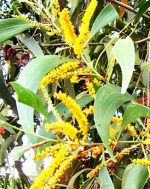 Earleaf acacia, also known as wattle, is an evergreen tree native to Australia, Indonesia, and Papua New Guinea and is currently invasive in the pinelands, scrub, and hammocks of south Florida where it is displacing native vegetation. A member of the bean family, Fabaceae, it has nitrogen fixing bacteria and can live in nutrient-poor soil. A shallow spreading root system gives rise to one or more crooked trunks with gray bark and carrying an open, spreading crown of dense foliage with thick leathery leaf-like structures. Loose spikes of yellow-orange fragrant flowers are followed by a flat somewhat woody pod containing shiny black seeds that are attractive to birds. The rapidly growing plants are tolerant of a wide variety of soils and do best in full sun on moderately moist soil in tropical environments. USDA Hardiness Zones 9-11
Earleaf acacia, also known as wattle, is an evergreen tree native to Australia, Indonesia, and Papua New Guinea and is currently invasive in the pinelands, scrub, and hammocks of south Florida where it is displacing native vegetation. A member of the bean family, Fabaceae, it has nitrogen fixing bacteria and can live in nutrient-poor soil. A shallow spreading root system gives rise to one or more crooked trunks with gray bark and carrying an open, spreading crown of dense foliage with thick leathery leaf-like structures. Loose spikes of yellow-orange fragrant flowers are followed by a flat somewhat woody pod containing shiny black seeds that are attractive to birds. The rapidly growing plants are tolerant of a wide variety of soils and do best in full sun on moderately moist soil in tropical environments. USDA Hardiness Zones 9-11
The following native are recommended alternatives:
Pond Apple (Annona glabra)
This tropical evergreen fruit tree is native to Florida, the Caribbean, Central and South American, West Africa and South Asia where it grows in wet soils including swamps and brackish water. The flowers are attractive and the fruits are edible. Hardiness USDA Zones 10-11
Virginia Live Oak (Quercus virginiana)
This very large mounding tree has a picturesque appearance with its broadly oval to rounded crown of dark green evergreen leaves. It is native to woodland edges, clearings, and shores from coastal regions of Virginia, south to Florida and west to Texas and Mexico. Hardiness USDA Zone 8-10
Photo by -Bùi-Thụy-Đào-Nguyên